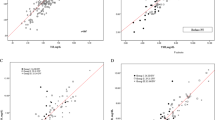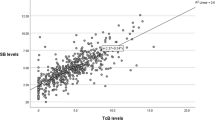Abstract
Objective:
To determine the accuracy and precision of transcutaneous bilirubin (TcB) measurements in preterm neonates.
Study Design:
Neonates were stratified into three groups on the basis of gestational age: 24 to 28 weeks (Group 1, n=30), 29 to 31 weeks (Group 2, n=29) and 32 to 34 weeks (Group 3, n=31). TcB was measured using the Draeger Air Shields JM-103, and when possible, measurements were made by two observers. TcB and total serum bilirubin (TSB) measurements were compared, and interobserver precision for TcB measurements was assessed.
Result:
Correlations between TcB and TSB ranged from 0.79 to 0.92. Most of the differences between TcB and TSB were ±2 mg per 100 ml, and there was no trend for the difference to increase with increasing bilirubin values. Sensitivity, specificity and negative predictive values ranged from 0.67 to 1.0, 0.29 to 0.81 and 0.60 to 1.0, respectively. Intraclass correlations were 0.87 to 0.92.
Conclusion:
TcB correlates significantly with TSB in preterm neonates, and interobserver precision is significant. Routine measurement of TcB in preterm neonates may provide enhanced clinical monitoring for hyperbilirubinemia.
This is a preview of subscription content, access via your institution
Access options
Subscribe to this journal
Receive 12 print issues and online access
$259.00 per year
only $21.58 per issue
Buy this article
- Purchase on Springer Link
- Instant access to full article PDF
Prices may be subject to local taxes which are calculated during checkout


Similar content being viewed by others
References
Maisels MJ . Transcutaneous bilirubinometry. NeoReviews 2006; 7: e217–e225.
Engle WD, Jackson GL, Stehel EK, Sendelbach DM, Manning MD . Evaluation of a transcutaneous jaundice meter following hospital discharge in term and near-term neonates. J Perinatol 2005; 25: 486–490.
Maisels MJ, Ostrea Jr EM, Touch S, Clune SE, Cepeda E, Kring E et al. Evaluation of a new transcutaneous bilirubinometer. Pediatrics 2004; 113: 1628–1635.
Rubaltelli FF, Gourley GR, Loskamp N, Modi N, Roth-Kleiner M, Sender A et al. Transcutaneous bilirubin measurement: a multicenter evaluation of a new device. Pediatrics 2001; 107: 1264–1271.
Kazmierczak SC, Robertson AF, Briley KP, Kreamer B, Gourley GR . Transcutaneous measurement of bilirubin in newborns: comparison with an automated Jendrassik-Grof procedure and HPLC. Clin Chem 2004; 50: 433–435.
Bhutani VK, Gourley GR, Adler S, Kreamer B, Dalin C, Johnson LH . Noninvasive measurement of total serum bilirubin in a multiracial predischarge newborn population to assess the risk of severe hyperbilirubinemia. Pediatrics 2000; 106: e17. Available at http://pediatrics.aappublications.org/cgi/content/full/106/2/e17.
Wong CM, van Dijik PJE, Laing IA . A comparison of transcutaneous bilirubinometers: SpectRx BiliCheck versus Minolta AirShields. Arch Dis Child Fetal Neonatal Ed 2002; 87: F137–F140.
Willems WA, van den Berg LM, de Wit H, Molendijk A . Transcutaneous bilirubinometry with the Bilicheck™ in very premature newborns. J Maternal-Fetal Neonatal Med 2004; 16: 209–214.
Karolyi L, Pohlandt F, Muche R, Franz AR, Mihatsch WA . Transcutaneous bilirubinometry in very low birthweight infants. Acta Paediatr 2004; 93: 941–944.
Knüpfer M, Pulzer F, Braun L, Heilmann A, Robel-Tillig E, Vogtmann C . Transcutaneous bilirubinometry in preterm infants. Acta Paediatr 2001; 90: 899–903.
Maisels MJ, Kring EA . Accuracy of transcutaneous bilirubin (TcB) measurements in preterm infants. Pediatr Res 2004; 55: 458A.
Stillova L, Matasova K, Mikitova T, Stilla J, Kolarovszka H, Zibolen M . Evaluationoftranscutaneousbilirubinometry in preterm infants of gestational age 32–34 weeks. Biomed Pap Med Fac Univ Palacky Olomouc Czech Repub 2007; 151: 267–271.
Amato M, Huppi P, Markus D . Assessment of neonatal jaundice in low birth weight infants comparing transcutaneous, capillary and arterial bilirubin levels. Eur J Pediatr 1990; 150: 59–61.
DeLuca D, Zecca E, deTurris P, Barbato G, Marras M, Romagnoli C . Using Bilicheck™ for preterm neonates in a sub-intensive unit: diagnostic usefulness and suitability. Early Hum Develop 2006; 83: 313–317.
Donzelli G, Pratesi S . Transcutaneous bilirubinometry in healthy preterm newborns. Clin Biochem 2000; 33: 505–508.
Ebbesen F, Rasmussen LM, Wimberley PD . A new transcutaneous bilirubinometer, Bilicheck, used in the neonatal intensive care unit and the maternity ward. Acta Paediatr 2002; 91: 203–211.
Yasuda S, Itoh S, Isobe K, Yonetani M, Nakamura H, Nakamura M et al. New transcutaneous jaundice device with two optical paths. J Perinat Med 2003; 31: 81–88.
Namba F, Kitajima H . Utility of a new transcutaneous jaundice device with two optical paths in premature infants. Pediatr Int 2007; 49: 497–501.
Ballard JL, Khoury JC, Wedig K, Wang L, Eilers-Walsman BL, Lipp R . New Ballard Score, expanded to include extremely premature infants. J Pediatr 1991; 119: 417–423.
Portney LG, Watkins MP . Foundations of Clinical Research: Applications to Practice, 2nd edn. Prentice Hall Health: Upper Saddle River, NJ, 2000 pp 579–580.
Maisels MJ, Kring E . Transcutaneous bilirubinometry decreases the need for serum bilirubin measurements and saves money. Pediatrics 1997; 99: 599–601.
Dai J, Krahn J, Parry DM . Clinical impact of transcutaneous bilirubinometry as an adjunctive screen for hyperbilirubinemia. Clin Biochem 1996; 29: 581–586.
McKenzie S . Anemia. In: Spitzer AR (ed). Intensive Care of the Fetus and Neonate, 2nd edn. Elsevier Mosby: Philadelphia, 2005 pp 1283–1294.
Anand KJ, Hall RW . Love, pain and intensive care. Pediatrics 2008; 121: 825–827.
Acknowledgements
We thank the following neonatal nurse practitioners for their dedicated participation in this study: Nikole Armstrong, MSN, NNP, BC, Liza Benfatti, MSN, NNP, BC, Elise Chiles, NNP, BC, Kim Clipp, MSN, NNP, BC, Donna Frederick, MSN, NNP, BC, Angela Graffeo, MSN, NNP, BC, H Kay, MSN, NNP, BC, Susan Kuehn, BSN, NNP, BC, Staci Nathan, MSN, NNP, BC, Brenda Owens, MSN, NNP, BC, Cheryl Pittman, MSN, NNP, BC, Leslee Roberts, MSN, NNP, BC and Lois Yarborough, NNP, BC.
Author information
Authors and Affiliations
Corresponding author
Additional information
Presented in part at the Pediatric Academic Societies Meeting, Honolulu, HA, 5 May 2008.
Rights and permissions
About this article
Cite this article
Schmidt, E., Wheeler, C., Jackson, G. et al. Evaluation of transcutaneous bilirubinometry in preterm neonates. J Perinatol 29, 564–569 (2009). https://doi.org/10.1038/jp.2009.38
Received:
Revised:
Accepted:
Published:
Issue Date:
DOI: https://doi.org/10.1038/jp.2009.38
Keywords
This article is cited by
-
Transcutaneous bilirubin levels in extremely preterm infants less than 30 weeks gestation
Journal of Perinatology (2023)
-
Reliability of transcutaneous bilirubin determination based on skin color determined by a neonatal skin color scale of our own
European Journal of Pediatrics (2021)
-
The forehead is a better site than the sternum to check transcutaneous bilirubin during phototherapy in sick infants
BMC Pediatrics (2020)
-
Rate of rise of total serum bilirubin in very low birth weight preterm infants
Pediatric Research (2020)
-
The accuracy of transcutaneous bilirubinometry in preterm infants
Journal of Perinatology (2020)



